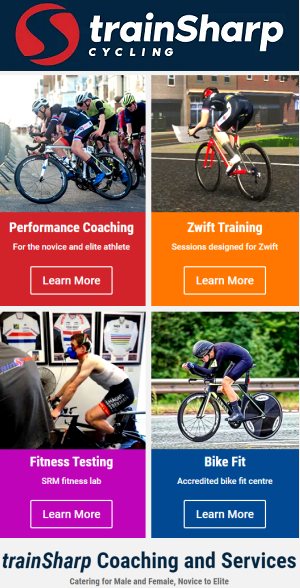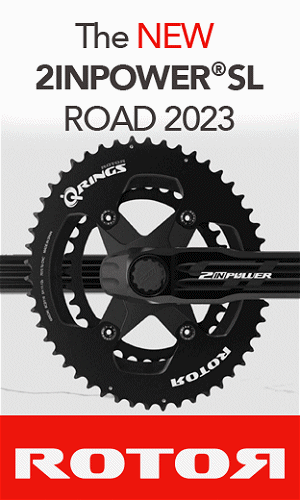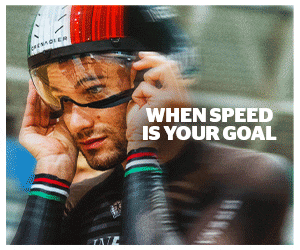Riders not only look like the pros they aspire to be but are also training like the pros with the help of professional training aids like the SRM Power Cranks
Larry Hickmott writes… It’s still January and so many of you will still be in training mode as the racing season on the road doesn’t start for around a month, longer for some riders. Prior to Xmas, VeloUK spoke to many riders from classic winners to track world champions to those at the top of their game in time trialling and they all talk about using a Power measuring device on their bike in their training programmes. I had to investigate!
Two examples of such interviews were with Magnus Backstedt and Matt Bottrill.
A valued sponsor of VeloUK is Trainsharp, sponsors of the Ingear racing team and distributors of SRM Power Cranks, which for me, was the first piece of equipment on a bike I saw that measured a rider’s power. But what is power? I turned to Jon at Trainsharp to provide some answers.
“It is the force you can produce at the pedals over the time it takes you to travel over one revolution†says Jon. “Or Power= Force x distance and time!â€
I knew I shouldn’t have asked!
We’re talking sports science here and I won’t even pretend to understand it but Jon also understands the need to put things into plain English and so adds, “Press harder (force) and move it quicker (speed)!â€
As my friend the meerkat would say, ‘simples!’
Chris Froome looks down at the SRM box during a Time Trial. Photo Graham Watson.
Having worked with the GB team for so many years (a decade or so), I got used to seeing the SRM cranks on their bikes, road and track, and sports analysts taking the data boxes and downloading the data to a computer to show the rider the data belonged to. The SRM power crank is still used by GB today but the power cranks are also available to the general public who want to make the most of their training.
The distributors of SRM cranks in Britain is TrainSharp, a UK based cycle coaching company set up by Jon Sharples and in partnership with Sean Yates. Together, they make a formidable coaching team. VeloUK asked Jon why is ‘Power’ such a useful benchmark to train by?
Jon started by explaining that the winter is an ideal time to really make the training count when the body is no longer drained by the efforts of racing and training. “Making the most of the winter months for effective training is vital for success next season” Jon says.
When talking to Jon about the importance of winter training, he spoke of it being a period when ‘cellular changes’ need to be made, something that isn’t done so much during the summer when the body is fatigued with the continuous cycle of racing and training. But what did he mean by ‘cellular changes’ I asked?
“Training the body so you have more power for the same heart†he replied. “The changes are made in the body through differing types of training and using zones or energy systems wisely†Jon explained. “Most riders are over training in the winter and under training in the summer.â€
It was all getting to a point when I understood why they call it ‘sports science’ and just how technical it can be and also why many riders invest in coaches, as I did when racing, to understand the science before presenting them with the training programme in plain English.
As anyone who has followed cycling for a while will have seen, the use of power in training has had a significant impact on the professional circuit, not just for riders but the teams and coaches within those teams.
The SRM power cranks on the bike of Alex Dowsett during the TT Champs in 2011.
It is commonplace on the web now to see riders at training camps on rigs with power measuring devices, quite probably an SRM device, where the team’s coaches see where their riders are at with their training before sending them off with power devices on their bikes and setting a programme for them to train at certain zones based on a measurement of power; watts.
“Training with power is more reliable than using your heart rate, which is susceptible to many variables especially in the winter months when the air temperature is cold” Jon told VeloUK.
“Because the body is cold, it is harder to raise the heart rate so it is easy to over train in the winter. The SRM powermeter is a scientific tool that accurately tracks power and these precise measurements mean that you are able to train for your highest functional threshold power (FTP), and don’t over train.”
Suddenly I was starting to lose Jon… what’s ‘functional threshold power’ I had to ask?
“There are a few terms used by training providers such as critical points, turn over points, ‘sweet spots,’ Lactate Threshold, and Function thresholds.. all very confusing and contradictory†Jon explained.
“It’s generally agreed that your ‘Functional Threshold Power’ is the maximal power output you can “sustain†for the duration of one hour.â€
“It’s NOT your “average” power. As average will not be the same as ‘sustained’. There are quite a few ways to test for ‘Functional Threshold Power’ but for the novice, the most effective way is to ride for 20 minutes as hard as you can – this gives for slightly more accurate results or you could do a one hour test (a 25 mile/40k TT) and get pretty much 100% accurate results from that.â€
Julia Shaw also spotted using SRM power cranks at the British TT champs.
“On this 20 minute ride (or a 10 mile TT), after downloading, take your average power figure for the timed interval and you’ve got 105% of your functional threshold. It’s not as accurate as performing a full hour test, but it’s definitely less stressful, easier to fit in to a busy schedule, and for the level of training we undertake, this will be good enough – if you are wanting to accurately pin point any personal landmarks, it will be best to take a fitness test with a cycle coach.â€
“Being a competitive bike rider means raising your FTP should be your first goal. Being more efficient at making use of our overall fitness ensures you will improve at a faster rate. Training for the highest FTP is what is going to out-perform others when it counts, not the maximal power output. You may have a 1300 watt gallop but if you’ve only got a 220 watt FTP, will you even finish with the bunch to contest the sprint?â€
“Although 99% of races are won with a sprint, it won’t necessarily be the strongest sprinter in the race that takes first place. After a well planned winter and a new FTP at 280w (and not 220w) you’ll have a much better chance of being around to contest any finish.â€
“Functional threshold power gives you a benchmark to creating your future training zones.â€
Australian sprinter Shane Perkins with an SRM box under the saddle. The GB riders do the same as do other nations.
An investment in being a more competitive bike rider…
Unlike a decade ago, training with an SRM power meter is now an investment all competitive riders can make. In my day, only 15 years ago (seems like yesterday), it was the Polar heart rate monitor which was the in thing for training and I remember my coach setting my training zones based on heart rate.
With the introduction of the power meter, that coaching tool soon became the benchmark for coaches and whereas many years ago, it was the device only used by pros and national teams like GB, nowadays it’s commonplace for power measuring devices to be used by riders at all levels. Quite a few of the bikes in the TT Champs had powermeters on them.
So whereas 15 years ago I would have been set an interval at a set heart rate for a set time, now riders can perform intervals at an exact wattage for a set time. The real time data from the SRM power meter allows you to immediately analyse your power output, giving you a benchmark to create or adjust your training plan.
Such data says Jon, is accessible enough to be used by you or with the guidance of a cycling coach and they too are an ever popular aid by riders trying to make the most of fulfilling their potential. A recent chat with a new coaching company who already had a large group of clients shows the ambition there is out there from riders of all ages to be better riders.
No hiding with a coach and a powermetre
One thing I quickly learned during my racing days under the guidance of a coach was that there was no hiding place and with a powermetre, the coach has even more of an idea of just how well your training session went.
“Your coach will see from your SRM data if you performed your training session correctly, how this affected your power and if you kept within your power thresholds†says Jon. He goes on to say “using a power meter allows you to pace your efforts, as it gives you a threshold you need to stay beneath to protect you from exhaustion.â€
I think it is safe to say that powermetres such as the SRM’s are a valuable tool for riders wanting to get more from their training. Far too many pros and other riders are using them for the SRM not to be a great aid for helping a rider/coach get the most from a training session. I still had questions though which I put to Jon.
 Like, how much of a groupset needs to change to install an SRM system? “You get a complete new chain-set (both crank arms and chainrings etc) and I fit them free. They are fairly simple to fit but I can show the customer around them and answer all the questions on how they work as well as how to read and understand the software.â€
Like, how much of a groupset needs to change to install an SRM system? “You get a complete new chain-set (both crank arms and chainrings etc) and I fit them free. They are fairly simple to fit but I can show the customer around them and answer all the questions on how they work as well as how to read and understand the software.â€
Having trained so much with a heart rate monitor, I asked Jon how would a person’s training differ if they went over to using an SRM system? “Training with power is the new heart rate monitor if you like†he says.
“Heart rate training has a limitation of time lag. This lag maybe seen when you are performing short intervals or climbing a hill. The heart rate can take several seconds or minutes to ‘catch up’ and will also remain elevated for some time afterwards. So you can see why interval training doesn’t really begin until you hit the target intensity and heart rate isn’t as effective with today’s training methods.â€
“Heart rates can be directly related to the power you generate but there might be days when you’re heart rate is telling you to slow down – heart rates are very variable on a daily basis. They can be influenced by many things such as excitement, dehydration, stress, sleep quality, or even the air temperature.â€
“It’s common that in the winter, riders will work very hard to drive the heart rates into the zone (almost over training) and then in the summer when the temp is warm the rider will back off as heart rates are very lively.â€
“The power cranks though allow a rider to measuring and record your fitness level in real-time and track your development over time. They help you to train in your correct training zones with the aid of the most accurate power, cadence and heart rate measurement.â€
“They also let a rider collect race data which they can use to better focus their efforts in training as well pacing themselves in time trials with power or heart rate limits.
Not having used an SRM System, I asked Jon finally what data an SRM provides for a rider? “The SRM Training system saves and provides you with the following values on the power meter – Power/heart rate/cadence/speed/riding time/riding distance/ temperature/energy consumption/ average and maximum values/ un-limited number of training intervals/ training times in any training zones plus you get multiple ways to analyse the riding time using the SRM software which comes with all units and is free to download.â€
Michael Hutchinson riding for Ingear, a team sponsored by Trainsharp.
“The SRM Training System measures all the data needed to organize your training and to analyse your race efforts. The SRM measures the applied torque and cadence at the most direct point of application – the crankset. This gives you the benefit of reliable power data. In addition, the SRM also measures heartrate, speed/distance, energy, altitude and temperature.â€
So there you have it. An introduction to the use of power cranks. Looking though my galleries of pictures, I see more and more riders using them (some used here) and for those looking to be a better bike rider, a faster bike rider, perhaps the SRM is just the thing you need to focus the mind on your training and use it more effectively. Thanks to Jon at Trainsharp for his inside knowledge!






















